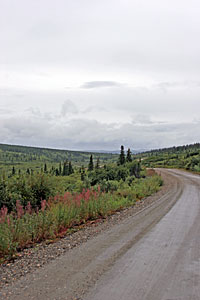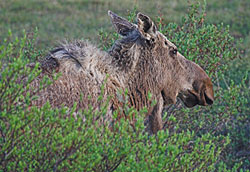Nome-Council Road
Mile 53–72 – Skookum Pass to Council
Habitat: Alpine tundra, side slopes, boreal forest, tundra meadow, and river valley

It doesn’t take long before the first spruce trees begin to appear on the landscape. The mountains you have just crossed tend to separate the moderating effects of the coastal Bering Sea climate—cool summers and windy, moderate winters—from the extremes of an interior climate—hot summers and deeply cold, calm winters. With the different climate regime and the presence of spruce forest, deciduous trees like birch and aspen, very tall willow, and alder shrubs, you are likely to encounter many new bird species along this section of the road. While some species like golden eagle, glaucous gull, northern shrike, swallows, raven, sparrows, and warblers straddle boreal and tundra habitats, don’t be surprised to find any of the following birds along the last 20 miles of the road to Council: spruce grouse, bald eagle, osprey, northern goshawk, great horned owl, northern hawk owl, boreal owl, belted kingfisher, downy woodpecker, three-toed woodpecker, gray jay, black-capped chickadee, boreal chickadee, ruby-crowned kinglet, varied thrush, Bohemian waxwing, yellow-rumped warbler, dark-eyed junco, rusty blackbird, pine grosbeak, and white-winged crossbill.
The Balancing Act Between Moose and Bears
Moose numbers along the Fox River and Niukluk River drainages were robust during the 1980s but a series of deep snow winters and too few willows to sustain the population led to a population crash in the early 1990s. Since then the willows have recovered but not the moose whose numbers remain depressed, the result of a healthy grizzly population, which regularly preys on moose calves.
Mile 68 — Fox River Bridge
Habitat: River valley and boreal forest
Descending into terrain increasingly dominated by trees and willows, you are more likely to see a moose than a muskox. In late summer grizzlies feed on spawning chum salmon below the Fox River bridge. Salmon carcasses also attract red fox, gulls, and common ravens. Both abandoned and active beaver lodges and dams are found along the Fox River drainage. Dolly Varden, chum and pink salmon, and Arctic grayling can be seen from the bridge.
The narrow and swift-flowing river downstream is hemmed in by dense vegetation. Spotted sandpipers may be seen on a sand bar on the east side of the road. Belted kingfishers burrow into the banks of the river to nest.
Mile 68 - 72
Habitat: Tundra meadow and wet tundra

The final section of the Nome-Council Road travels through habitat that is unlike any other along the road system—open parklands dotted with clusters of tall spruce trees. Northern harriers hunt voles, shrews, and lemmings in the meadows. In years of abundance, you may see snowshoe hares licking minerals from the roadbed. Lynx also frequent the area when snowshoe hares are abundant. Moose feed on aquatic plants in the lowland ponds.
Notable Wildlife
- Northern harrier
- Whimbrel
- Godwits
- Lynx
- Moose
